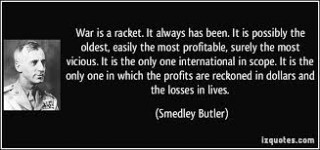1933 Classic by Major General Smedley Butler
by Dr Stuart Jeanne Bramhall
Published in 1933 by retired Marine Major General Smedley Butler, War is a Racket is a classic expose of the role of Wall Street profiteering in instigating war.
Butler’s book begins with the startling statistic that World War I created 21,000 new millionaires and billionaires. President Woodrow Wilson borrowed (from Wall Street banks) the $50+ billion to pay for World War I, increasing the national debt from $1 billion to $52 billion. Of this amount, $16 billion was pure profit. Butler lists specific companies, starting with Du Pont and US Steel, and the obscene profits they made from World War I.
He also deplores the systematic inefficiency and fraud that caused the War Department to pay two to three times the retail charge for equipment such as saddles and mosquito nets that had no possible use in a modern European war. This was on top of millions spent on poorly crafted wooden ships that sank when put to sea and airplanes that were technologically obsolete by the time they were delivered.
Wilson had been elected to his second term based on a campaign promise to keep the US out of the Great War. War is a Racket also discusses his secret White House meeting with a European commission that caused him to reverse himself. After informing Wilson the allies were losing the war, they warned that they couldn’t repay the $5-6 billion they owed American bankers, manufacturers and munitions makers if they were defeated.
Butler maintains the real reason the US entered the war was to protect these Wall Street interests. Obviously this isn’t what Wilson and his Committee on Public Information (run by Edward Bernays, the father of public relations) told the American people. They would be barraged with incessant propaganda about the Germans being monstrous barbarians and the Great War being the war to end all wars because it would make the world safe for democracy.
Free PDF of War is a Racket: click here
Major General Smedley Butler is best known for foiling the 1933 Bankers’ Putsch. This was a failed military coup, instigated by America’s leading bankers and industrialists, to remove Roosevelt from office and replace him with a Mussolini-style dictatorship. Butler, who was recruited to lead the coup, blew the whistle to the House McCormick-Dirkson Committee. They responded by launching a cover-up. Details of the Bankers’ Putsch only became public knowledge in 1967, when journalist John Spivac uncovered the committee’s secret notes.
Dr. Bramhall is a retired American child and adolescent psychiatrist, activist and political refugee in New Zealand.
Her first book The Most Revolutionary Act: Memoir of an American Refugee describes the circumstances that led her to leave the US in 2002. She has also published two young adult novels about political activism: The Battle for Tomorrow: A Fable
View All Books by Dr. Bramhall >>>
She is involved in the national leadership of the New Zealand Green Party and has a political blog at StuartJeanneBramhall.com
ATTENTION READERS
We See The World From All Sides and Want YOU To Be Fully InformedIn fact, intentional disinformation is a disgraceful scourge in media today. So to assuage any possible errant incorrect information posted herein, we strongly encourage you to seek corroboration from other non-VT sources before forming an educated opinion.
About VT - Policies & Disclosures - Comment Policy




